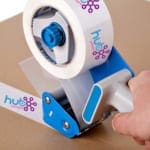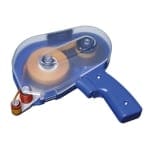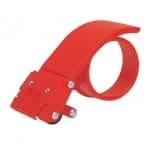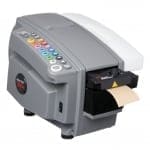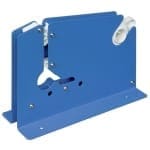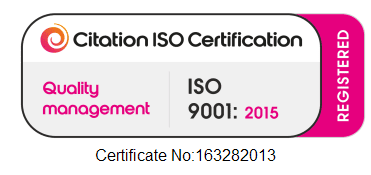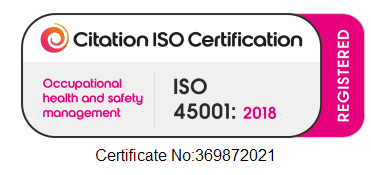The Facts on Tape Dispensers
Dispensers for adhesive tapes largely fall into two categories – hand held and bench mounted – so that’s where we’ll start talking about them.
Hand dispensers are versatile, inexpensive and of course portable, designed to be used with one hand so that the other hand is free to securely hold the carton align the flaps as they are sealed together. Possibly the most widely used version is the tape gun, also called the pistol grip dispenser, even though they don’t really resemble any form of weaponry. Even in its most basic form, a tape gun holds the tape roll on a spindle, feeds it around a roller so it can be applied to the carton and cuts it off with a serrated blade when the dispenser is tilted forwards. The handle is mounted under the tape spindle, roller and blade so that the tape can be applied and cut with one smooth movement. A plastic flap mounted above the blade then flicks against the loose tape end and attaches it to the carton.
Generally the spindle will have some form of braking mechanism on it that prevents the tape roll from rotating unless the tape is being applied to the carton. An adjustable brake lets the operator to set the tension to match the force needed to release the tape from the roll and the tension needed for a good quality seal.
Other features to look for on a tape gun are
- Tape control – this uses suction or a static charge to hold the tape end against the application roller and prevent it from flapping around, which can result in it annoyingly folding over and sticking to itself or to the dispenser.
- Blade protector – this is a hinged plastic flap that covers the blade when the gun isn’t in use. Particularly when they’re new the blades can be quite vicious, so it’s nice to know that it won’t take a bite out of a passing finger, but they are also to protect the blade from getting damaged if the gun is dropped. Maybe we should say when it’s dropped, because that happens quite frequently.
- Trigger activated blade – an alternative to the blade protector, this holds the blade safely inside the body of the gun when it’s not being used and during the taping process. A trigger built into the handle (possibly where the gun and pistol names come from) is squeezed and the blade emerges to cut the tape, then disappears again when the trigger is released.
- Double frame – most tape guns are designed to take a standard 50mm wide tape, but they are also manufactured for 75mm and 100mm wide tapes. A double frame holds the tape spindle at both ends so that the tape tension is even across its width.
Tape guns are also made for filament tapes. These tapes are reinforced with strands running along the length of the tape (monoweave) or along and across the tape (crossweave). The main difference with these tape guns is that the blades have coarser serrations that will more easily cut through the filaments.
The standard spindle diameter on a tape gun is 75mm, although some guns are manufactured with smaller spindles for high-capacity rolls holding up to 200 metres of tape (standard rolls are 66 or 132 metres long).
Double sided tapes also have their own tape gun design featuring a secondary, smaller diameter roller that stores the backing paper removed from the tape as it is dispensed.
Another variation of the hand dispenser is the carton sealer. This doesn’t have a separate handle like the tape gun, and encloses the tape within the frame of the sealer. One type of sealer has a hinged cover that holds the cutting blade, and tension is applied to the tape by pressing down on the cover. Fully enclosed carton sealers have a clip-on side panel for changing the tape roll, and protect the tape from contamination and edge damage.
Bench dispensers are good for use at a fixed packing station, where the carton can be placed on a stable, flat surface. To stop them from moving around the bench while the tape is being dispensed, these may be hollow and filled with sand to weigh them down, be pre-drilled so they can be secured to the bench with screws, or have a separate clamp to secure them to the edge of the work surface.
As with tape guns the standard spindle is designed to take a 50mm wide tape on a 75mm diameter core, but some dispensers have interchangeable cores that will also take smaller core diameters. Other dispensers have multiple cores mounted on the same spindle so that different tapes can run side by side. This might be for three 25mm wide tapes, one 25mm and one 50mm tape, two 25mm and one 50mm tape or two 50mm tapes.
Electronic bench tape dispensers make cartons faster and easier to pack as they can be programmed to dispense tapes in consistent lengths. As one tape length is removed from the dispenser, the next length is prepared for use. This is particularly useful for water activated (gummed paper) tape as the dispenser also pre-moistens the tape to activate the adhesive. Here’s one in action:
A bag neck sealer is a type of bench dispenser designed for a particular purpose – you will undoubtedly have seen the strip of tape securing the neck of a plastic bread bag, although its use isn’t confined to bakery products. It feeds the neck sealer tape across a series of rollers in a vertical channel on the dispenser (this is called the ‘throat’). When the twisted neck of a bag is pushed down into the throat, the rollers wrap the tape around the neck, create an additional tail of tape that holds the tape together and then sever the tape from the roll.
An additional feature of some bag neck sealers is a neck trimming blade. While this may conjure up images of Sweeney Todd, the neck trimming blade actually has a less bloodthirsty purpose – it removes any excess bag neck a short distance away from the tape to make a neater finish. Some bag sealers are made from plastic or stainless steel so that they are compatible with food processing and corrosive environments.
Like many packaging processes, carton sealing can also be made more productive and more uniform with a case taper. These are designed to simultaneously seal the top and bottom flaps of cartons as they pass through the taper. Suitable for use as a standalone unit or to be fully integrated into a packing line, case tapers use extra high capacity tape rolls that reduce the frequency of stoppages for tape change.
A ‘uniform’ case taper is perfect for sealing higher volumes of identically-sized cartons, as the carton width and height are pre-set and need no adjustment from one carton to the next. A ‘random’ case taper is however more versatile, although slightly slower, as it will detect the width and height of each carton as it enters the taper, automatically centring the tape on the flaps and at the correct height.
Speak to Lester Coldrick, our Technical Sales guru about upgrading your production line with a Case Taper or other Auto or Semi-Auto machine/tool – lester.coldrick@hub-packaging.com
Lester Coldrick
Technical Sales & Service
Hub Packaging Limited
Tel: +44 (0) 28 4175 4977
Email: lester.coldrick@hub-packaging.com


